Two-Way Sync is the Future of Work: Here’s Why
The days of every team working in their corner out of the same software are long gone. Now, everyone has access to a vast array of dedicated tools to get their work done. But that comes with a drawback; the tool silo.
When everyone’s working from their own platform, their work becomes trapped within that tool’s boundaries by default. That means any process that involves multiple teams has to hop over those boundaries – a challenge that often involves manual syncing or complex API integrations. That’s why the integration market exploded, pretty much in line with the growth of the software tool market.
But while there are many options for leaders looking for integration solutions, one type of solution will emerge above the rest as the new standard: 2-way sync. Instead of trying to manually sync updates from one device to one system, this process allows information to flow from one app to another. Internal systems, accounts, details, can all be shared across multiple devices, ensuring everyone has the latest information to work with. Here’s how — and why it matters.
In this article:
- Centralized vs. distributed truth
- Functional structure vs. cross-functional work
- Automation or integration?
- What is two-way sync?
- How to tell true 2-way syncing from imitators
Centralized vs. distributed truth
Optimizing the modern workflow
The search for a single source of truth is a perfectly natural reaction to a simple reality: truth is everywhere. Whether you’re managing a sales pipeline, a marketing campaign, or a software development workflow, you’re dealing with individual nuggets of truth spread out over multiple tools, teams, and collaborators. Finding the right answer in these nuggets can provide a host of benefits, but if the wrong one falls through the cracks or gets deleted, it can have a devastating impact on your broader workflow.
Sales pipelines – a truth minefield
Take a sales pipeline, for example. What elements of truth do you have to deal with here between apps on your computer or cell phone? There’s contact information for any potential lead, sure. There’s also collateral or documentation that might have been sent out to each account.
If you offer a free trial, then you potentially have multiple data points reflecting how they’re using your product or service. Then there’s every message, email, and conversation you’ve had with them, as well as fixes or features the lead’s waiting on.
Already, you’re dealing dozens of little bits of truth, spread out over messaging tools, contact management software, a pipeline management platform, support tools, development tools and more. With a sales process often coming down to quick reactions and having the best information available, it’s natural to want a single place where everyone in that process can get the information they need.
With a single source of truth, data is pulled from every tool in your process and transferred to one platform. This centralizes truth that’s naturally spread out over multiple tools.

And that’s the main problem. Trying to establish a single source of truth just creates one massive silo and forces everyone into it.
Distributed truth: a networked approach
Your processes are made of networks of distributed truth. Every collaborator can only make the best decisions when they can work within that network from their tool of choice. A single source of truth can’t do that. But a united, distributed source of truth can:
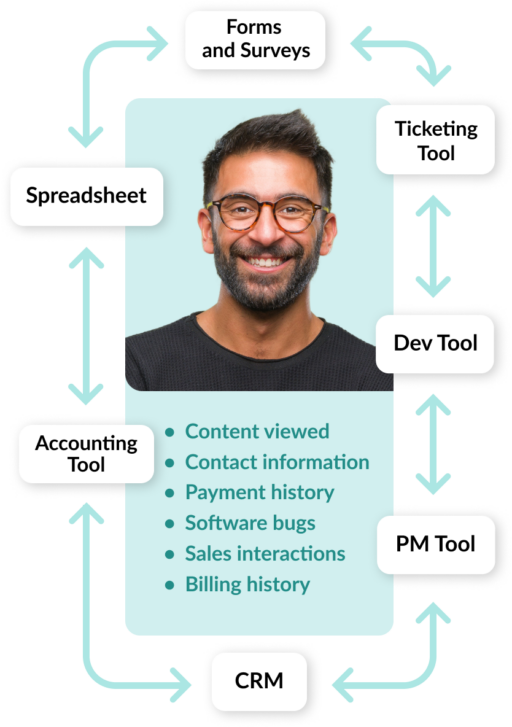
Let’s take the sales pipeline example again. Imagine a salesperson has to deal with a lead they’re trying to re-engage. Imagine this lead is the difference between making this month’s quota or not. It’s not just that one salesperson’s commission on the line, but the whole team’s performance is at stake.
That salesperson needs to know if there are any open support tickets affecting that lead, when the last conversation happened, what their product usage is, and more. Do you think a single source of truth can give them the ability to quickly pull up all that information from their tool of choice?
This is just one example of a process that drives the need for adding an integration solution to your tool stack. But why does this need exist in the first place?
Do you need help aligning your marketing and IT teams on common business goals?
Our team interviewed nearly two dozen senior executives from organizations including LinkedIn, Salesforce, Meta, HubSpot, and many more. Get their insights, advice, and best practices on how to align departments on shared business goals in our free eBook.

Functional structure vs. cross-functional work
Distributed truth is hard to collect in one place because we don’t build our tool stacks to match the way we work. They match the way our organizations are structured.
The functional organization model
No matter what industry you’re in, your teams are organized along the functions you expect them to perform. Marketers are organized in teams — like public relations and digital marketing — that fall within a marketing department. Developers are arranged according to their specialty, from full stack developers to back-end specialists, or by application module, all within the same department. The same is true for HR, operations teams, and the rest of the organization. While you might have individual collaborators with a different skill set within a team, like a developer in a marketing team, they’re still “part of the team.”
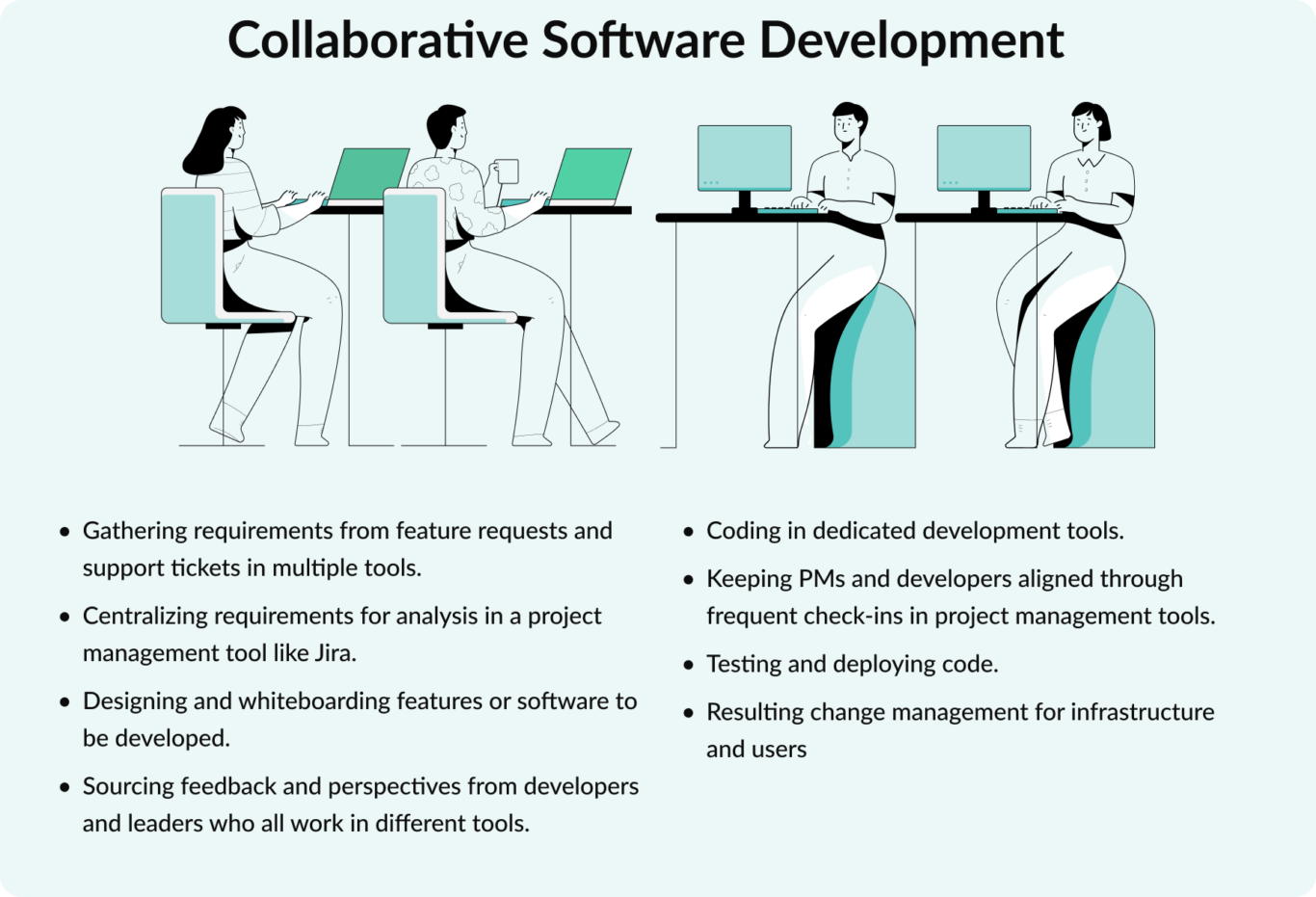
Is it any surprise, then, that each team assembles their own tool stack, regardless of what anyone else is using?
Cross-functional work needs cross-functional tools
If everyone worked exclusively within department lines, this wouldn’t be a problem. But the reality is nearly all workflows cross those lines. That’s because they depend on cross-functional work.
Marketers work more closely with developers and product managers than ever before. Customer success and sales teams rely on experts throughout the company to help them close deals and hold on to valuable customers. Recruiters work with marketing to create assets that attract new talent. There isn’t a single workflow that can’t benefit from the input of multiple teams and multiple departments.
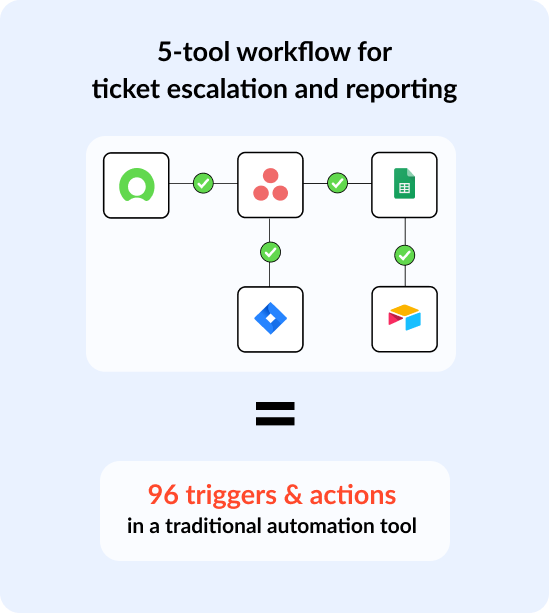
That sort of cross-functional collaboration becomes all the more challenging when you look at all the tools each team uses — and how little those tools actually interact.
We all know the number of tools we’re using has exploded in recent years. But what about the tools that don’t even go through typical acquisition channels? The tools you don’t even know your teams are using?
Shadow IT is already a big problem for organizations: 80% of workers admit they use SaaS applications that weren’t approved by IT. But the proliferation of apps and services built in-house, using no-code and low-code platforms, is an even bigger problem.
“Fifty-seven percent of small to midsize businesses (SMBs) have had high-impact “shadow IT” efforts occur outside the purview of their official IT department. Of that group, 85% currently have a shadow IT team operating in the business right now.”
Capterra study of 300 IT professionals and project managers
So not only is each team acquiring tools that match their department’s needs, but soon they’ll be building their own. That leads to distributed truth across more apps than you can imagine, and it’s going to make having the right integration solution more important than ever.
Automation or integration?
The market for software integrations isn’t the same as it was six years ago — when Unito first saw the world. It’s a crowded market, full of big-time players across all categories, from workflow automation solutions to massive iPaaS (integration-platform-as-a-service) options designed for enterprise clients with big IT departments and bigger budgets.
The state of integration
Most of the integration solutions you’ll find on the market now use one or more “traditional approaches” for api integration. This technology has existed for decades and hasn’t changed dramatically, beyond becoming somewhat more accessible for some business users trying to keep files up to date between apps.
Most of the integrations on the market today fit in one of these three categories:
- One-way automation: These integrations use simple, trigger-based logic to power automations in a huge repertoire of tools. A trigger might be, say, “when an email is received,” while the action is “create a new task in my project management tool.” These integrations are often known as iPaaS and workflow automation solutions.’
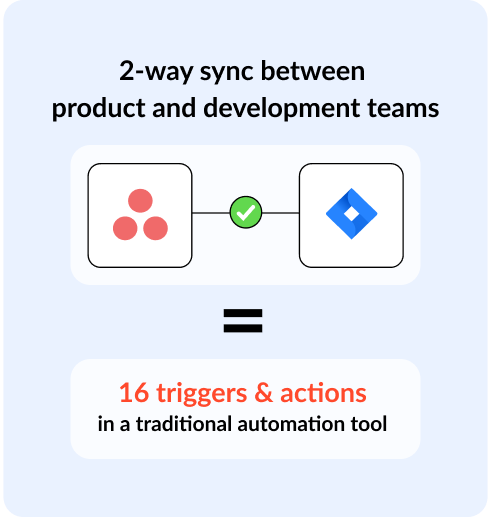
- Native integrations: These are integrations that are built into your software tools. They’re much simpler than even automation solutions, often just plucking a few lines of data, an attachment, or a link from one tool and displaying them in another. However, their advantage is that you can use them without leaving your tool of choice.
- Extract, transform, load tools: These tools are essential for maintaining databases, building detailed reports, and getting more out of your data. They pull data from your SaaS tools of choice, transform it, and load it into databases and similar platforms. They’re exclusively one-way tools. These are called ETL and Reverse-ETL tools.
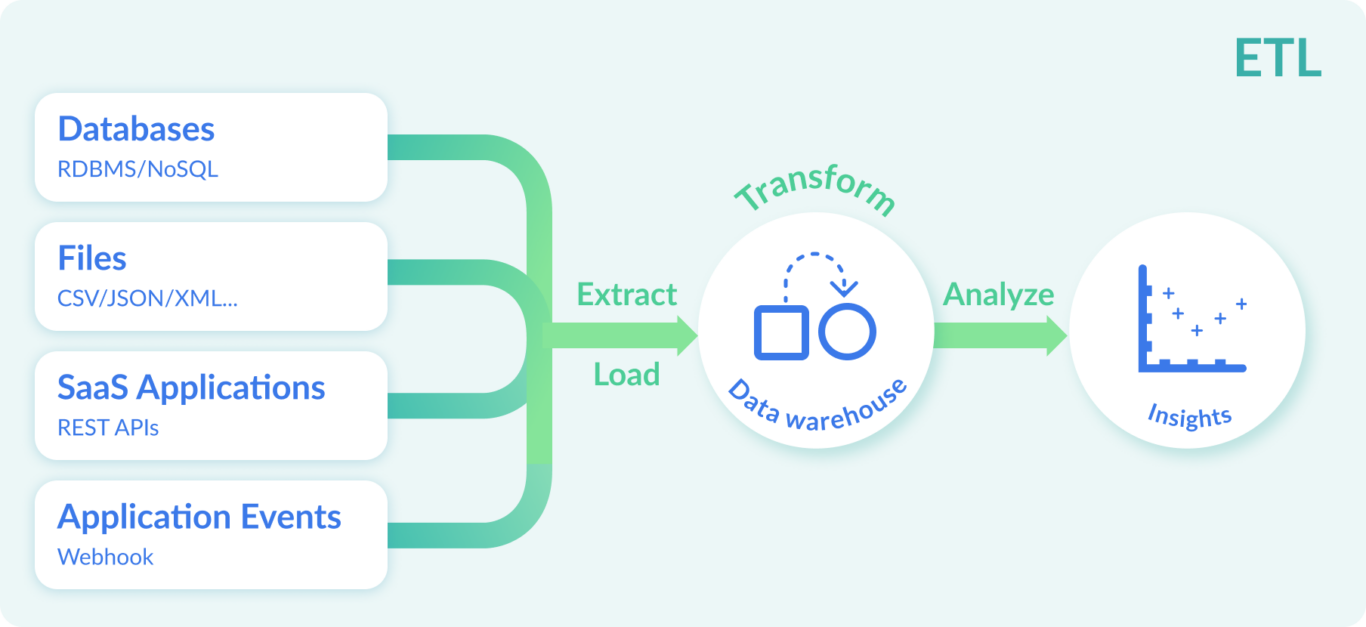
Most of the robust integration tools on the market fall within one of these categories. They’re great for automating large batches of repetitive tasks, but they don’t actually bring your tools together.
The traditional approaches to integration aren’t enough
Even seemingly simple actions can create chaos in a distributed workflow. Imagine a crucial support ticket sent to your team’s shared mail account gets deleted by an Android user on their phone. Without a robust system for instantly relaying and updating information across platforms, this deletion could go unnoticed. Notifications might be missed, and the ticket unresolved.
So how can you utilize APIs to monitor your devices, ensuring any change – e.g., if you delete a file on your phone – is instantly reflected across all related tools and platforms? A one-way automation can work to help you create or save data by request, but only in a single direction. What happens if you delete files from the destination app?
Main drawbacks of 1-way automation
These solutions are straightforward, easy to learn, and widely applicable. It’s not uncommon to find an automation platform with hundreds of integrations, since the simplicity of the logic can easily be replicated across tools. But their main drawback?
They’re one-way.
Once an automation runs its course, it’s over. It might create a new work item in your tool, but there’s no relationship between that item and the one that created it. That means updates made in one tool won’t be reflected in the other.
How many of your workflows work in exclusively one direction? Is there any process in your business that doesn’t depend on constant collaboration between teams and across tools?
Despite one-way automations ruling the integration market, they’re not enough for your workflow. That’s why the market needs a new standard: 2-way sync.

What is two-way sync?
If an automation is a one-way sprint, two-way sync is a relay race for your devices, data, and apps. A team of people working together towards one common goal, passes the baton to another until they cross the finish line.
A two-way sync solution doesn’t just create work items in one tool or another. It creates a relationship between work items that carries updates back and forth between them. That means work can continue in any device, across app interfaces, without anyone missing messages or updates. Less catching up needs to happen in those messages, chat tools and emails, since everyone can see what’s going on from their device and tool of choice.
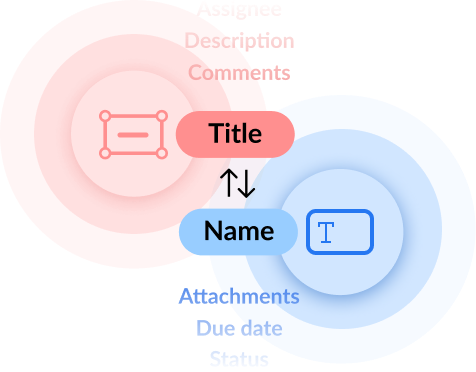
The bite-sized version? Automations go in one direction, once, then they’re done.
They’re like wrapping up your work neatly before throwing it over a wall. You don’t see it land, can’t tell if the other team got it, and have no idea what’s happening in other accounts. Sometimes you get a window. But a window doesn’t let you do more than peek in on the other side.
How does 2 way sync compare to an API integration?
2-way sync connects various apps and internal systems. Unlike manual syncing or 1-way API integrations, two-way sync offers a more user-friendly approach that automates related data from app to app.
Here’s the basic idea: you configure the two-way sync to connect to the servers of each application or system you want to integrate. This connection is often established through APIs (Application Programming Interfaces), which essentially act as a translator between different systems.
Once connected, the 2-way sync can be configured to turn on auto sync, meaning it will constantly monitor for changes in either system. If a new record is created in one system, the two-way sync will automatically create a corresponding record in the other system, and vice versa. This ensures that everyone has access to the most up-to-date information, regardless of which system they’re working in.
A 2-way sync solution doesn’t give you a window. It smashes the wall down to grant access to a wider range of accounts, systems, and related devices.
Why should two-way sync be the standard?
Because it matches your workflow’s needs. There isn’t a single business process that can survive on one-way automations alone, not without involving a ton of manual work, missed messages or updates, and frustration.
Hard boundaries between teams and departments are a thing of the past. It’s interesting that no matter what industry you work in, your daily to-do list depends on other teams just as much as it does the people on your team. And because each team uses its own tools, you need to have a way to bridge the gaps between them.
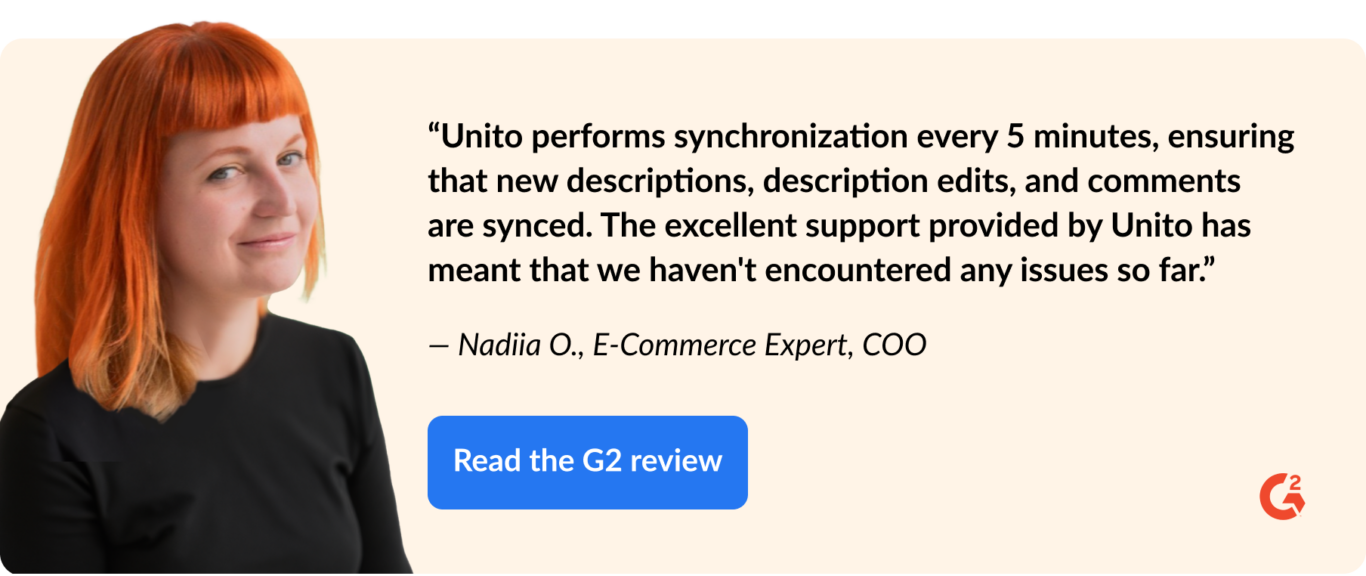
Automations are like taking a file and sending it on to another team through a garbage chute. There’s no way to know if your work actually ended up in the right place, no way to get feedback, and no way to check on updates. Not great if you need to collaborate over time.
With a 2-way sync, it’s like having every department, every team, and every collaborator sitting right by your side. You can communicate with them, collaborate with them, and keep them updated in a snap, no matter which tools everyone is using.
What is auto sync?
A true 2-way sync platform should enable you to either manually sync data from the platform itself to keep data aligned when you need it synced. And, it should also offer the ability to turn auto sync on, which sends data back and forth between synced apps whenever manual changes are made.
Two-way sync and distributed truth
One-way integrations and automation solutions can only send data along a path. When your work tool is just one node in a network of distributed truth, that makes a one-way integration little more than a window into that network. You can send things through, even get an eye on the broader process, but that’s it. Say you’re escalating a support ticket to the development team. With this approach, you send it off, it disappears in a hole, and you might get a few updates by email or chat — if you’re lucky.
With a 2-way sync solution, you’re able to participate actively in every bit of the process, no matter where your tool sits in that network of truth. That’s because these solutions keep everything updated throughout your process. Your support ticket is visible in your tool of choice, and you see all the updates from the development team as they prioritize it, work on it, and complete it. You can even provide context and guidance from your tool.
How to tell true 2-way syncing from imitators
It’s not impossible to build something approximating a two-way sync with an automation solution. In fact, some of those solutions even advertise themselves as two-way sync solutions. That said, they don’t provide true two-way syncing. And if it’s not true, then your workflow will suffer for it.
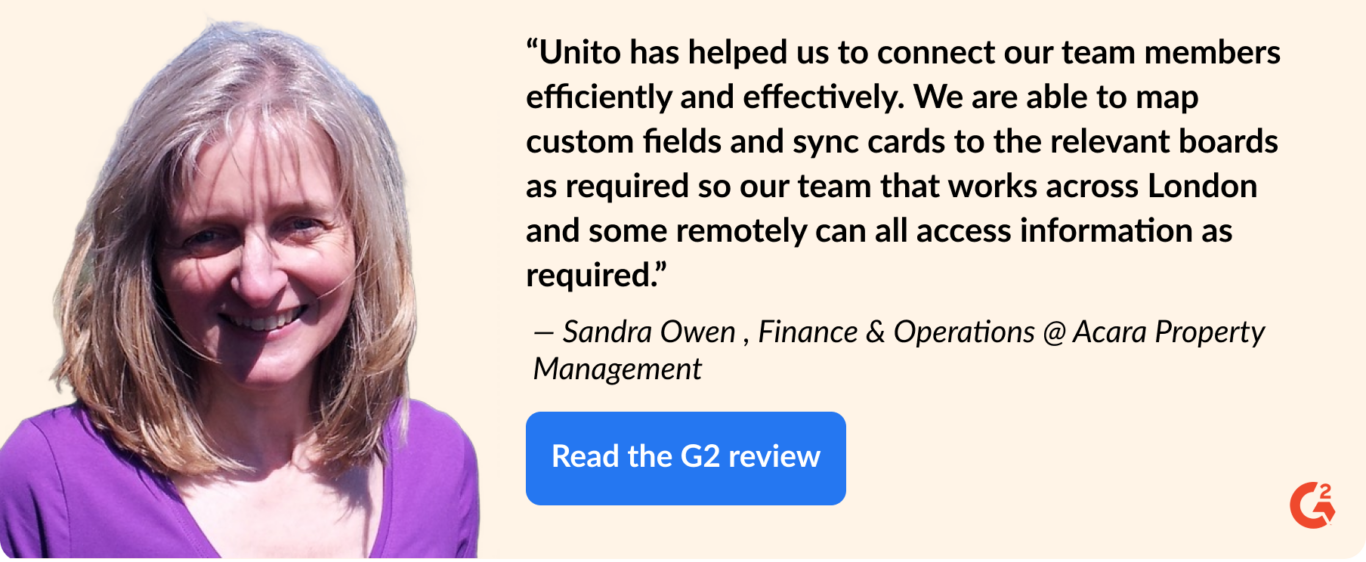
Here are just a few questions to ask yourself when trying to determine if a workflow management solution is an automation or true 2-way syncing:
- How long does it take to set up? A 2-way sync solution can support any number of work items between your tools with a single setup. An automation solution will ask that you build multiple automations to make this happen, regardless of the number of settings. You’ll need one per operation (e.g. creating a new work item in one tool or updating a specific field). And if you want things to update in both directions, you’ll need to double that number. That can add up to dozens of automations.
- Is there a risk of an infinite loop? With an automation solution, you run the risk of creating work items endlessly until someone spots the mistake. A true 2-way sync solution has ways of automatically detecting these loops and keeping them from happening through configurable settings — rather than expecting you to do it yourself.
- Can it handle hierarchy? Individual automations stop at a single work item or, at best, a single field in that work item. For example, a new lead in one platform might create a new task in a project management tool. But that’s where it ends. A 2-way sync solution works across all levels of your work item, natively, and automatically. That includes comments, subtasks, attachments, custom fields, and more.
- Does someone need to constantly manage it? When your “2-way sync” operates on a foundation of a dozen automations, it’s easy for something to go wrong. Unless you have someone keeping an eye on your workflow, you might start wondering about missed deadlines and more requests for updates before realizing your automation went bust. But the right 2-way sync platform will offer accessible notifications when this happens to enable a swift response.
- Who’s doing the work? 2-way sync involves technical work to match up work items from both tools and prevent issues. In a true 2-way sync solution, that work is happening behind the scenes with auto sync. Once you turn auto sync on, your data updates automatically based on manual actions by your team. In an imitator, you’re expected to do that work yourself. That can take setup time from minutes to months.
How does 2-way sync compare to an internal integration?
Sometimes this question gets referred to as: “should I build or buy?” Internal integrations offer more control, but they come at a much higher cost. Maintenance, integration team salaries, and of course the opportunity cost of dedicating IT resources to this process. Can your server handle the bandwidth? Where will you keep the stored records? Is your data fully encrypted while in transit?
2-way sync solutions work in the background and they do what they say they do. You don’t need to build a patchwork of one-way automations to achieve a real relationship between your work items. And while there may be many imitators out there, take that as a sign that 2-way syncing is slowly becoming the standard for the integration market, rather than the outlier. It’s best to get ahead of the curve while you still can.


